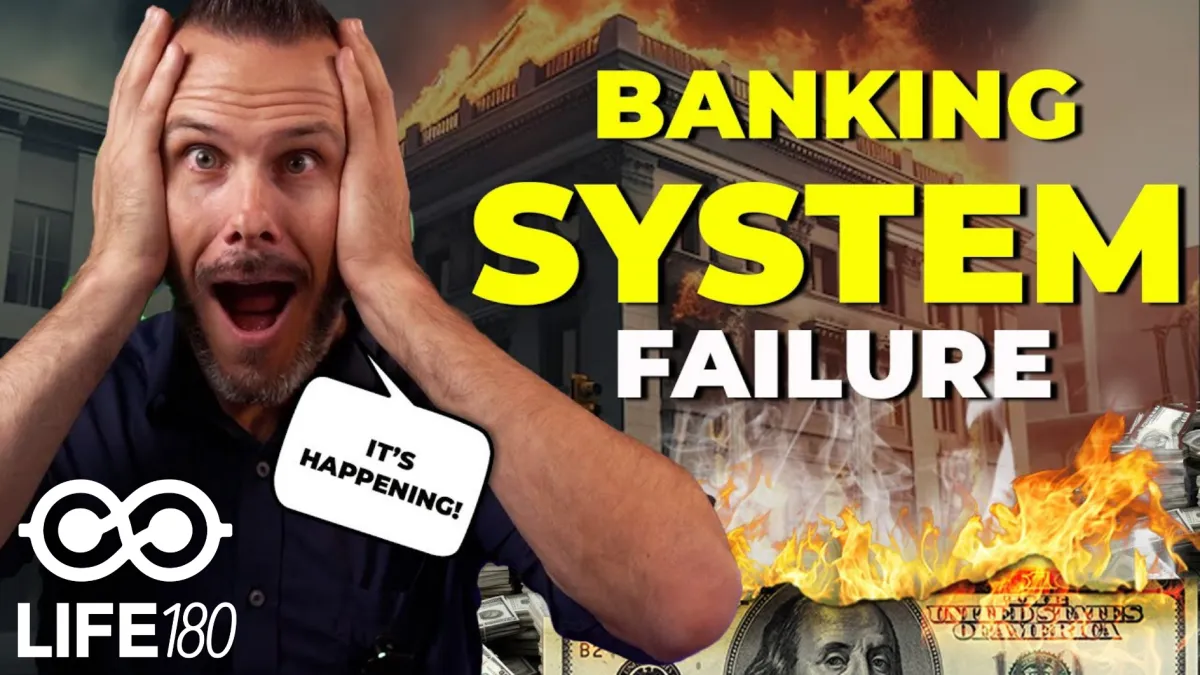
Simplifying Financial Confusion
LEARN CASH FLOW HACKING TO REACH FINANCIAL FREEDOM
Used by 90% of millionaires to reach their financial goals 4x faster

Achieve Financial Freedom Through Cash Flow Hacking

Increase Your Lifestyle While You Build Your Wealth

Position Yourself to Thrive in Market Downturn
YOU SHOULD NOT FEEL OUT OF CONTROL ABOUT YOUR FINANCIAL STRATEGY

Have easy access to your money in case of emergencies and opportunities

Use the investment strategy 90% of millionaires use

You deserve a clear plan to consistently grow your money and avoid market uncertainty

Have a guide and advisor that has your best interest in mind

Do not overpay in taxes

Stop guessing at the best vehicles to protect and grow your money

Major banks CRASHING in 2024 - ECONOMY in trouble!
This article is a written adaptation of the video you can find on the LIFE180 YouTube channel.
Today, we are addressing the potential for banking failures in 2024. As of late June, the first significant banking collapse of the year occurred on April 26, when Republic First Bank, not to be confused with First Republic, which failed last year, became the initial casualty of 2024. This incident has sparked widespread concern about the possibility of additional banking failures in the near future.
In this article, I aim to explore the potential causes of banking failures. We'll examine the real dangers, identify which banks are at risk, and discuss what actions you can take to protect yourself. For some, these risks are more significant than for others, making it crucial to understand the landscape and be prepared.
Ultimately, I want to provide complete transparency based on my research regarding the factors that may lead to potential banking failures in 2024. I believe the likelihood of more banking failures is extremely high.
So, without further ado, let's delve into what my research has revealed and share these insights with you.
Elevated Interest Rates Will Lead To Banking Failures
The first reason I believe more banks will fail in 2024 is due to the elevated interest rate environment we are currently experiencing. Unfortunately, many people do not fully grasp the negative impact that higher interest rates have on the banking structure and infrastructure.
There are five specific reasons why elevated interest rates negatively impact banking performance, increasing stress on banks' balance sheets and raising the likelihood of banks going out of business.
“This slows down borrowing and banks aren’t getting new money”
The first reason is that when interest rates rise, it affects the functionality of our fiat currency system and the fractional reserve banking system. The Federal Reserve raises interest rates to pull money out of circulation when inflation gets high. This reduces the amount of money available in the economy.
Essentially, this means that higher interest rates slow down borrowing. Since banks primarily make money from lending, an increase in borrowing costs leads to a decrease in borrowing activity. As a result, banks generate less profit.
People are hesitant, holding onto their money due to increased uncertainty about future decisions. This cautious behavior means banks are not generating new money, leading to significant challenges.
“People are defaulting”
The second reason high interest rates are problematic is that they reduce available cash flow for individuals, placing added stress on businesses and contributing to overall economic uncertainty. This leads to decreased consumer spending as people become more cautious with their finances.
Debt levels are rising, especially for individuals with variable interest rates such as those with Home Equity Lines of Credit (HELOCs). Many people obtained these credit lines, which now carry higher costs due to elevated interest rates. Similarly, businesses relying on revolving credit lines are facing similar challenges.
Previously, these debts were manageable with interest rates ranging from two to four percent. However, with rates now elevated to eight to nine percent, the increased cost of interest alone is placing significant financial strain on borrowers.
This uptick in financial pressure has resulted in higher default rates, increasing costs for banks, which compounds the issue further.
“People are moving money from banks to other banks that have higher yield savings accounts”
Now part number three, when banks are relying, especially these regional banks, they don't have the highest savings yields. The high yield savings accounts that people are flocking to in the four and a half to 5% range right now, they're typically not at these banks that are failing.
So, and the reason is because what happened is these banks that have invested in short-term bonds or long-term bonds, they invested in at lower rates and so they can't really afford to pay out the high yields. It's the banks with the newer investments that are able to pass those benefits along to its account holders.
And so when you look at the fact that people are moving their money from these regional banks to other banks or from smaller banks to banks where they're able to get higher yields in their savings accounts if they have those savings, what that does is on top of the fact that people are defaulting, on top of the fact that people are not taking new loans at higher rates to create more profit for the bank, and then they're moving money.
It basically, it creates a lot of stress with these withdrawals on these banks that is really causing a ton of stress. And so that gets me to the next point.
“Banks also bought bonds at lower rates and that is hurting them in the higher rate environment”
Reason number four why higher interest rates are detrimental to banks is their impact on bonds. The elevated interest rates not only affect banks directly but also have a negative ripple effect on bond markets.
In addition to depositors withdrawing their funds from banks to invest in bonds, banks themselves are facing losses because they previously invested in bonds at lower interest rates. This mismatch in investment returns further exacerbates the financial strain on banks in the current high interest rate environment.
Now that interest rates have risen, the bond portfolios that banks have invested in are experiencing losses. This presents a significant challenge for banks as their investments are now less profitable or even incurring losses due to the higher interest rate environment.
“Banks had elevated deposits due to historically low bonds”
Point number five relates to the withdrawal of deposits from bank accounts. Many individuals had funds in savings accounts despite low returns, as investments like bonds, CDs, and other fixed assets were not yielding favorable returns. This scenario made it unappealing to lock money into long-term investments with minimal interest rates.
Now, with some bonds offering returns as high as 5.5%, 6%, or even 6.5%, individuals have started withdrawing money from savings accounts that they don't immediately need access to and instead are investing in these bond portfolios.
Investors and savers are now redirecting their funds into actual bonds issued by companies or treasury bonds. This shift is driven by the opportunity to earn higher interest rates in the current environment. Consequently, money is being withdrawn from banks as people opt for these bond investments.
Once again, this trend places stress on banks by reducing the funds available in their balance sheets. Many people may not realize that banks depend on new deposits to sustain their operations. This dynamic underscores a critical aspect of the banking system that some liken to a self-admitted Ponzi scheme.
Is the Banking System A Ponzi Scheme?
Consider this: If banks rely on continuous new deposits to sustain operations and pay out old depositors, it resembles a Ponzi scheme. Without ongoing influxes of new funds, banks risk failure. The current elevated interest rate environment is shedding light on this vulnerability within the banking system, revealing its structure for what some argue it to be.
In reality, the banking system operates under regulations and mechanisms designed to prevent it from collapsing like a Ponzi scheme. However, the comparison highlights the critical importance of stable deposit flows and prudent financial management.
To recap, the primary reason more banks are expected to fail is the sustained elevated interest rate environment. There appears to be no indication of interest rates decreasing in the near future, which further compounds the challenges faced by banks.
There's been considerable discussion about Jerome Powell and the Federal Reserve potentially reducing interest rates due to economic pressures. However, the fear remains that lowering rates could reignite uncontrollable inflation.
Over the past several months, despite ongoing speculation, the Federal Reserve has refrained from actually reducing rates whenever discussions have arisen. This cautious approach reflects their concerns and the delicate balance required in managing economic stability.
When examining the current economic data, it becomes apparent that lowering interest rates may not be feasible. On the contrary, many indicators suggest that the economy needs to endure its current course. There's a prevailing argument that if anything, interest rates should be increased to address lingering inflation concerns.
The Fractional Reserve Banking System Is Actually The Reason Banks Will Fail
Now let's delve into the second reason, in addition to the high interest rate environment, why more banks may face failure is the inherent nature of the fractional reserve banking system. So what does that mean?
In a fractional reserve banking system, the money you deposit is not actually held in the bank. Instead, banks view your deposit as a liability because they owe you that money. I've created a short, humorous video explaining this concept, where I parody the workings of the banking system in about three minutes. It effectively highlights the system's flaws and how it can resemble a scam.
The bottom line is that in a fractional reserve banking system, your money isn't kept in the bank. Instead, when you deposit your money, the bank lends it out to others. The elevated interest rates exacerbate this issue, as they lead to a host of problems, such as reduced borrowing and increased defaults, which further destabilize the banking system.
Remember, before and during the early days of COVID, there were strict reserve requirements for banks under the fractional reserve banking system. Banks had to keep a certain percentage of deposits as reserves, typically around 10%. For instance, if a bank had a million dollars in deposits, it was required to maintain a hundred thousand dollars in reserves.
However, when COVID struck, the reserve requirements were removed, meaning banks no longer needed to keep any reserves against their deposits. So now, a bank with a million dollars in deposits isn't required to hold any reserves. This lack of a financial cushion means that even a minor economic downturn or loss can quickly spiral out of control for these banks, exacerbating their vulnerability and instability.
Without reserves, it's hard to consider banks as safe financial institutions. They have no financial cushion, which is problematic. Additionally, they've made poor investments, experienced a slowdown in new deposits, and faced increasing loan defaults from borrowers. These factors collectively undermine their stability and reliability.
These factors negatively impact all banks, but smaller banks are the most vulnerable. Local banks, in particular, will suffer the most, and this will have a cascading effect on the entire banking system.
The FDIC will step in to manage the fallout, merging struggling local banks into regional ones. Some of these regional banks will also fail and be absorbed by larger banks like Bank of America, Chase, and Wells Fargo. This consolidation will lead to bigger banks becoming even larger, exacerbating problems within the banking industry and reducing competition.
The worst part is that this ripple effect will lead to reduced access to services and capital for smaller local businesses, which are the lifeblood of our economy. Restricting their access to capital is detrimental, as these businesses primarily rely on local banks.
If local banks are absorbed by larger institutions, the ways in which these businesses access funds will change, disrupting the entire economic dynamic and potentially stifling growth and innovation.
The Commercial Real Estate Bubble Will Lead To Bank Failures
The third factor that I believe will lead to more bank failures is the current danger in commercial real estate. Approximately a trillion dollars of commercial real estate loans are set to mature soon. These loans will need to be renewed at interest rates higher than their original terms, which will significantly impact both borrowers and lenders.
This situation is likely to cause significant problems, including a reduction in commercial real estate valuations. Many property owners may find themselves unable to afford the higher payments, leading to negative cash flows. As a result, many commercial properties could end up underwater, exacerbating financial strain on both borrowers and lenders.
The banks most at risk of failure will be those heavily exposed to commercial real estate loans and with significant amounts of uninsured deposits. These are deposits exceeding the FDIC-insured limit of $250,000 per depositor. Banks relying on such deposits face increased vulnerability if they experience losses from commercial real estate defaults or other financial pressures.
When examining the recent failure of Republic First Bank on April 26, their significant exposure to commercial real estate loans played a crucial role. This exposure likely contributed to their inability to manage financial pressures effectively, leading to their collapse.
When we analyze the economy and its current trajectory, it's essential to consider fundamental factors such as inflation. Despite recent declines, inflation remains above 3%, which is more than 50% higher than the target inflation rate. While some may find relief in the decrease from the peaks of eight to nine percent seen a year and a half ago, we are still significantly distant from the target inflation level desired by the Federal Reserve.
This persistent inflationary pressure underscores ongoing economic challenges that could impact various sectors, including banking and financial stability.
Considering the current inflation rate above 3%, significantly higher than the Federal Reserve's target, the prospect of reducing interest rates before reaching the desired 2% inflation target seems unlikely in the near term. Such a move could potentially exacerbate economic instability and contribute to more banking failures.
Therefore, navigating the path to economic stability will require careful consideration of inflationary pressures and their implications for monetary policy and banking resilience.
The Good News - Even Amidst Banking Failures
Amidst concerns and discussions about potential banking failures, it's important to remain optimistic. Rather than succumbing to fear-mongering or doomsday scenarios, I advocate for aligning your financial decisions with your personal values and beliefs. This approach ensures that your money serves your long-term goals and supports a stable financial future, regardless of external economic uncertainties.
So there's no harm in keeping your money in the bank if that's what you choose to do. In fact, last year, fewer than 7% of depositors actually lost money as a result of banking failures.
These instances largely stemmed from bank consolidations, and for most people, the transition meant little more than a transfer of funds and perhaps some temporary inconveniences. While there can be some discomfort during such processes, the overall impact on depositors has historically been minimal.
But ultimately, the vast majority of people did recover their money. A 7% loss rate is relatively small considering the number of banks and the total amount of deposits involved in the failures of 2023. Looking ahead to 2024, if we face a situation akin to the widespread bank failures of 2008 or potentially even worse, the crucial question is where your risks lie.
Ways To Protect Yourself During Banking Failures
I believe the risks are relatively low, but there are still some important considerations to keep in mind if you find yourself in this situation.
The first step is to ensure your funds are within the FDIC insurance limit of $250,000 per depositor, per bank. If you have more than that, spreading your deposits across multiple banks is advisable. This diversification strategy helps mitigate risk and ensures that your funds are protected under the FDIC coverage limit across different financial institutions.
The next step is to consider using whole life insurance policies as a secure place to store your funds, providing a hedge against the risks associated with the fractional reserve banking system.
The fractional reserve banking system ties us into the fiat money system, which features an elastic currency. Many are concerned about the risks to the US dollar's status as the world's reserve currency and the potential implications for our banking system and the dollar's valuation if that status were to change.
Indeed, we must participate in the fiat money system to operate our businesses and manage our financial lives effectively. But lately, it's crucial to consider the worst-case scenario and implement systems that allow us to continue operating while safeguarding ourselves against potential risks.
If we have our money in banks, the strategy isn't necessarily to withdraw everything, but rather to diversify across multiple banks and consider allocating some funds to whole life insurance. Whole life insurance companies, with their long history of over 180 years, specialize in achieving high returns with minimal risk, making them a viable option for diversifying and safeguarding assets.
When considering the aim for minimal risk, it naturally limits the potential for higher returns. However, historically, whole life insurance companies have been able to deliver returns of around four and a half to 5% net to policyholders over the long term, after accounting for fees and expenses.
When comparing whole life insurance to a traditional savings or bank account, it often becomes apparent why it can be a sensible choice. While some may prefer other investment options, whole life insurance offers stability, predictable returns, and the added benefit of insurance coverage, making it a compelling alternative for safeguarding and growing your savings.
When considering the track record of bank failures since 2008, which has seen nearly 600 banks collapse, it's striking to contrast this with the resilience of participating mutually held whole life insurance companies. Since 1840, only one such company has failed, highlighting the stability and reliability that whole life insurance can offer as a financial safeguard.
Using Whole Life Insurance As A Banking Alternative
This underscores the exceptional financial stability of participating mutually held whole life insurance companies. They have demonstrated remarkable resilience by consistently paying dividends every year, even during economic downturns. This reliability underscores the strength and longevity of whole life insurance as a financial vehicle.
The potential protection against the risk of the US losing its status as the world's reserve currency is particularly compelling. These participating mutually held insurance companies have been around since 1840, during which time the US dollar has evolved through various iterations. This longevity and adaptability suggest a robust foundation that can weather potential shifts in global economic dynamics.
Looking back through history, the US dollar has gone through several iterations and significant changes. In 1840, it was a different version of the dollar, followed by another evolution in the 1870s. The pivotal year of 1913 saw the establishment of the Federal Reserve system, which privatized the banking system and introduced a new monetary framework. In 1944, the US dollar became tied to the gold standard, reinforcing its role as the world's reserve currency.
However, this linkage ended in 1971 when the US abandoned the gold standard. Despite these transitions, for most people, the management of money remained under the auspices of the Federal Reserve, providing a consistent anchor amid various changes in the dollar's structure and global status.
If you're interested in understanding more about the Federal Reserve and its historical context, I highly recommend reading "The Creature from Jekyll Island" by G. Edward Griffin. This book provides a comprehensive exploration of the Federal Reserve's origins and its impact on the US monetary system. It's a substantial read, but it offers valuable insights for anyone looking to delve deeper into these topics.
The reason I favor Whole Life Insurance as a secure repository for safe, liquid, and accessible capital over traditional banking is its resilience. Whole Life Insurance companies have shown the ability to adapt by adjusting their general fund investments in response to changes, including potential shifts in the US dollar's status as the world's reserve currency. This adaptability provides a reassuring layer of protection for policyholders' funds in uncertain.
This dual benefit of Whole Life Insurance allows you to participate in the current fiat money system while partnering with one of the most financially stable and successful institutions managing billions of dollars. Many successful individuals, banks, and corporations choose to invest billions into Whole Life Insurance contracts due to their stability and reliability, making it a preferred option for safeguarding substantial capital.
Absolutely, these insurance companies are poised to react swiftly to potential shifts in currency or economic conditions. Their proactive management and financial stability enable them to anticipate changes and secure assets effectively, positioning them ahead of potential risks to the US dollar's reserve currency status. This proactive approach underscores why many individuals and entities trust them with their financial security.
And the individuals entrusting these insurance companies with their wealth are among the most influential in the world. That's why I choose to place my money where these individuals trust theirs. It's just my perspective on financial security.
To safeguard against banking failures, it's crucial to have a comprehensive plan in place. For high net worth individuals seeking diversification, I strongly recommend considering a properly structured whole life insurance policy as an alternative.
Such policies typically offer comparable liquidity to traditional banking options, with minimal loss, often 10% or less, depending on how the policy is funded and structured. Moreover, they provide additional ancillary benefits that can enhance your overall financial strategy.
Ultimately, I believe the challenges in the banking system may escalate before they improve. The outcome remains uncertain, and while it might not affect everyone significantly, those impacted could face substantial consequences. Therefore, being prepared and having a solid financial strategy in place is crucial, especially if you find yourself in a vulnerable category.
The ripple effects on the world's reserve currency status of the US dollar are uncertain. It's unclear whether these challenges will strengthen or weaken its position in the global economy.
Different experts hold varying opinions on the matter. For instance, Peter Schiff may foresee a worsening situation, whereas Harry Dent might believe it could lead to improvement. The reality is, nobody can predict with certainty. It's all speculation until events unfold and reveal their actual impact.
Therefore, my goal is to place my money where I have confidence that the institution can adeptly pivot, regardless of the direction events take. I want to align myself with a company that excels in managing such transitions better than anyone else in the industry.
That concludes the article. If you found it valuable, please consider sharing it to spread the word. I hope you found these insights beneficial. Until next time, have a blessed and inspirational day!
HOW TO START TAKING CONTROL OF YOUR FINANCES BY MAXIMIZING YOUR CASH FLOW AND PROTECTING YOUR ASSETS

1. Schedule Your Free Clarity Call

2. Create a Free Customized Plan

3. Get Guide to Financial Success
GET YOUR FREE COPY TO STOP USING OUTDATED RETIREMENT STRATEGIES
Cash Flow Hacking teaches you to:
Protect Your Investments
Thrive in bad markets
Reach financial freedom faster

ARE YOU LOOKING FOR:

Cash Flow Hacking teaches you to:
Security to protect your money
Increased cash flow and lifestyle
Inflation protection
Financial certainty in all economic environments
A reduction in taxes
Safe and fast access to your money with no penalties
WHO IS THIS PROGRAM FOR?

People looking for an alternative
Are you looking for alternatives to Wall Street’s “buy and hold” strategy that takes 40 years with uncertain results? Our Cash Flow Hacking strategies provide you the building blocks to get started on the right foot

Passionate Entrepreneurs
Are you looking for a financial strategy that will take your best assets (you and your businesses) and multiply their potential? Our Cash Flow hacking strategies will teach you how to invest for the future without sacrificing building your business

Real Estate
Investors
Are you a real estate investor who is burned out from being a landlord or playing the fix-and-flip game? Our Cash Flow Hacking strategies will provide you with the system to create predictable wealth AND give you the freedom you are looking for.
YOU DESERVE PEACE OF MIND AND A PLAN THAT WILL PROTECT YOUR FAMILY AND GROW YOUR WEALTH
Today you need to be more savvy than ever if you try to go at it alone.
Losing money to inflation, taxes, and just poor investment strategies is leaving you frustrated, feeling out of control and not knowing where to turn. To add to the problem, the market is flooded with advisors who have outdated advice that does not place your best interests first, but instead focuses on charging you a fee that creates guaranteed cash flow for them.
NOT YOU
We believe this is wrong and that your security and best interests should be placed first. We believe you should be in a position where you control your money, your money doesn't control you. We understand because we talk with hardworking people everyday that are losing money in the markets based on old information and feel like they are guessing at the best course of action.
We created the Cash Flow Hacking plan to help you have security and control of your money to take advantage of life's opportunities because you deserve peace of mind with your wealth. The old way of planning for retirement of… Go to school Get a job & save as much as you can in your 401k and mutual funds...is broken.
You have been lied to. Think about it, where else in life does someone tell you that the most certain way to achieve your desired result is to take on more risk? The math just doesn't work, and the results are showing in our country and world. Did you know that 90% of millionaires in the United States have 1 asset in common?
Hint: it's not stocks or mutual funds (and no...it's not crypto) How much sense does it make for you to work hard, save money, reduce your current lifestyle (because that's what you are doing when you save for the future - taking money you could use on lifestyle today and delaying gratification to a future unknown time), and hope that whatever you are doing will work three to four decades from now? If you're thinking, "not much sense at all…", you are in the right place.
With over 50 years of experience on our team, we have worked with thousands of individuals and families to achieve financial freedom faster and with more predictability by helping them invest for Cash Flow.
How does the Cash Flow Hacking Plan work? 1. Take the Cash Flow Hacking Challenge 2. Complete the LIFE180 X-Ray and determine what your Freedom Number is 3. Work with a Cash Flow Hacking expert to provide you a customized plan
The customized Cash Flow Hacking plan will give you clarity on where you are now, where you want to go (and in what time frame), and what you need to do to get there predictably.
We value and commit to you: We believe you deserve the best financial education and guidance We believe financial decisions should not be rushed but be well thought out with a plan We believe you should be in control of your money We believe we earn your trust through time, education, and proper due diligence Without a proper plan and guidance, your money can be lost to taxes, inflation, and bad investments You deserve more with the most up-to-date strategies to mitigate your risk, control your money, and earn stable returns regardless of the market Schedule a call here to attain your LIFE180 Financial X-Ray now or get started with the Cash Flow Hacking Challenge for free.
I am interested in...